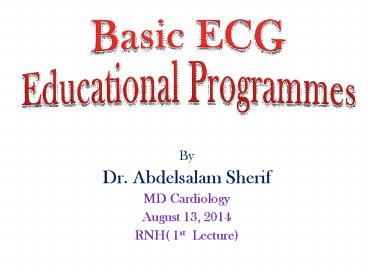Basic ECG 1 PowerPoint PPT Presentation
Title: Basic ECG 1
1
Basic ECGEducational Programmes
- By
- Dr. Abdelsalam Sherif
- MD Cardiology
- August 13, 2014
- RNH( 1st Lecture)
2
QUICK REVIEW OF HEART
- Purpose
- Pumps blood
- Basic Anatomy
- 4 chambers
- 2 sides
- 4 valves
3
THE CONDUCTING SYSTEM
- SA Node
- Inter-nodal pathway
- AV Node
- Bundle of HIS
- Bundle Branches
- Purkinje Fibers
4
RELATIONSHIP
5
Relationship
6
Activation Of The Heart
SA Node Normal Pacemaker
Hold It !
7
P
QRS
T
PQ
ST
PR interval
QT interval
8
(No Transcript)
9
Time
0.2 sec
0.04 sec
1 sec
10
Time
0.1 mV
0.2 seconds
1 milliVolt
Voltage
11
Cardiac Cycles
12
HOOKING UP THE 12-LEAD ECG
- Proper skin prep
- Placement of the limb electrodes
- Placement of the chest electrodes
13
ELECTRODE PLACEMENT
- LIMB LEADS
- CHEST LEADS
14
LIMB LEADS
- Bipolar leads
- I, II, III
- Augment leads
- AVR, AVl, AVF
15
RULING OUT LIMB LEAD REVERSAL
- AVR is always negative
- Lead I is always positive
- Lead II and III positive for the P wave and
usually the QRS complex
16
Chest Leads
17
CHEST LEADS
- 6 UNIPOLAR LEADS
- V1
- V2
- V3
- V4
- V5
- V6
18
CHEST LEADS
- CHEST LEADS
- COLUMN III
- R wave progression
- Small to Tall
- COLUMN IV
- R wave progression
- Tall to Small
19
(No Transcript)
20
Some Problems With The ECG
- Artifact
- Electrical interference
- Somatic tremor
- Wandering baseline
21
ARTIFACT ON THE ECG
22
THE ARTEFACT
23
BASELINE WANDERING
24
SOMATIC TREMOR
25
ELECTRICAL INTERFERANCE
26
(No Transcript)
27
Method" of ECG Interpretation
- 1. Measurements.
- 2. Rhythm Analysis.
- 3. Conduction Analysis.
- 4. Waveform description.
- 5. ECG interpretation.
- 6. Comparison with previous ECG ( if any ).
28
Determination OF Heart Rate
29
1st Method
30
2nd Method
31
2nd Method
32
Determination Of QRS axis
33
EINTHOVENS TRIANGLE
34
QRS Axis Determination
35
Axis in Normal range
36
Left Axis Deviation
37
Right Axis Deviation
38
Thanks
PowerShow.com is a leading presentation sharing website. It has millions of presentations already uploaded and available with 1,000s more being uploaded by its users every day. Whatever your area of interest, here you’ll be able to find and view presentations you’ll love and possibly download. And, best of all, it is completely free and easy to use.
You might even have a presentation you’d like to share with others. If so, just upload it to PowerShow.com. We’ll convert it to an HTML5 slideshow that includes all the media types you’ve already added: audio, video, music, pictures, animations and transition effects. Then you can share it with your target audience as well as PowerShow.com’s millions of monthly visitors. And, again, it’s all free.
About the Developers
PowerShow.com is brought to you by CrystalGraphics, the award-winning developer and market-leading publisher of rich-media enhancement products for presentations. Our product offerings include millions of PowerPoint templates, diagrams, animated 3D characters and more.

